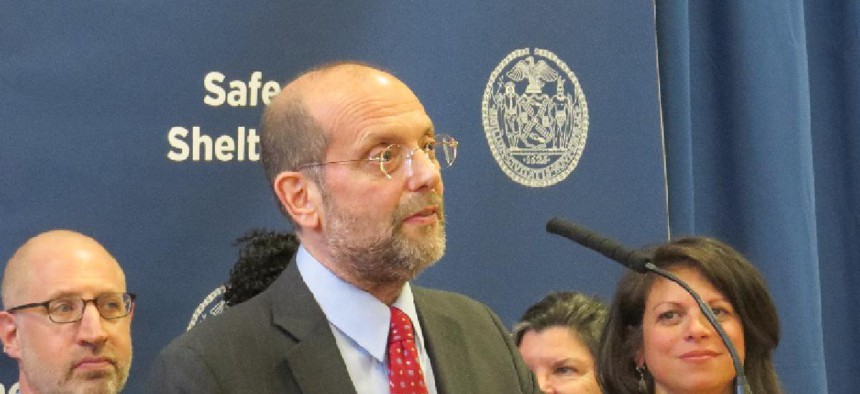Faced with a new era of rising homelessness in New York City, Mayor Bill de Blasio said his administration has reassessed the city’s decades-old approach and taken a cue from past administrations by – once again – integrating the Department of Homeless Services into the Human Resources Administration.
The de Blasio administration will restructure city government so the two agencies report to one commissioner and consolidate their homelessness prevention and housing units. This would shift the city’s focus back to preventing homelessness through services like rental assistance or providing legal representation to those facing eviction, de Blasio announced Monday at the BronxWorks settlement house, which sits beside a housing court with so much traffic that rope barriers were set up outside its Grand Concourse entrance.
“We believe in the fundamental changes we’re making,” de Blasio said. “We believe they are the right answers to a problem that was not addressed properly for too long. But we have no illusion this is going to be easy.”
Steven Banks, a former Legal Aid attorney who sued the city and forced it to provide all homeless families with shelter, will lead both organizations as Commissioner of Social Services. Banks said the city will appoint one administrator to head homeless services and another to oversee social services, both of whom will report to him.
Banks said the restructuring would create $38 million in savings by streamlining duplicative operations and management – but no layoffs would be involved. This $38 million will be part of a total investment of $68 million in homeless services included in the next budget. The mayor and Banks said the thrust of the city’s work would be aimed at curbing eviction and displacement, but when asked what sorts of related services the $68 million would fund, Banks said details would be presented in the executive budget.
“If you look at the two agencies and you have multiple back office functions – legal, finance, communications, program integrity, contracting – if we can streamline all of those procedures, we can save money and then repurpose those dollars into the very kinds of programs that people … need,” Banks said.
De Blasio said the demographics of who is homeless in New York City have changed “profoundly,” particularly as rising rents over the past decade drove many families and working New Yorkers out of their homes. He said the city’s strategy for aiding homeless people did not evolve, so in December his administration embarked on a 90-day review of its approach.
Over the course of this review, the city launched several initiatives, including the Homeless Outreach and Mobile Engagement Street Action Team, or HOME-STAT, where outreach teams tasked with trying to bring people staying on the street into shelters compile information on every homeless person they encounter in a central hub overseen by police and personnel from other city agencies. De Blasio increased the number of drop-in centers available to the homeless. He also took a number of steps to examine and enforce building violations in shelters and retrain and expand the security personnel monitoring these facilities.
De Blasio said the city’s efforts have produced results from a homeless problem he said has been growing since the first day of former Mayor Rudy Giuliani’s administration, when 23,500 people were in shelters. On de Blasio’s first day, that had grown to more than 50,000. Now, there are about 58,000 people in shelters. However, de Blasio estimated 78,000 New Yorkers would be relying on these facilities if the city hadn’t offered legal services and other aid. He said his administration had helped 32,000 move out of shelters and into permanent homes.
Following the review, the mayor said he was creating an Interagency Homelessness Accountability Council, which will coordinate homeless services across agencies under the direction of Deputy Mayor for Health and Human Services Herminia Palacio. The city will also be streamlining rental assistance programs and more aggressively enforcing a law that prevents landlords from discriminating against tenants based on their sources of income, for instance by rejecting rental vouchers, Banks said.
De Blasio highlighted the city’s long-term plans to create 15,000 units of supportive housing and build 80,000 new units of affordable housing. He called on the governor and state lawmakers to hash out how large state housing initiatives will benefit the city before the end of the legislative session.
“There’s this corrosive dust of cynicism that settled on this problem, and sadly, I think a lot of people doubt that anything is going to make a difference, but I stand here today … to say this reorganization and the emphasis on putting resources towards housing-based solutions is going to make a difference,” said Mary Brosnahan, president of the Coalition for the Homeless. “We want our folks up in Albany to push and have real reform that we see in the city and ramp up those state resources that we desperately need.”
Some of the other 46 reforms announced by de Blasio also require cooperation from Albany, including having the state participate in task forces working to stop discharging prisoners to shelters and to replace mental health shelters with community-based programs. The city wants the state to sign off on it using Medicaid funding to finance part of the apartment search process, such as paying realtor fees and security deposits, for homeless clients with disabilities.


